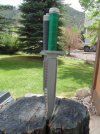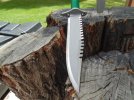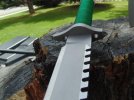Ausseknifeknut
BANNED
- Joined
- Oct 26, 2013
- Messages
- 1,254
Yeah , for a knife that's already been abused , and will never be used again .
The BladeForums.com 2024 Traditional Knife is ready to order! See this thread for details:
https://www.bladeforums.com/threads/bladeforums-2024-traditional-knife.2003187/
Price is $300 $250 ea (shipped within CONUS). If you live outside the US, I will contact you after your order for extra shipping charges.
Order here: https://www.bladeforums.com/help/2024-traditional/ - Order as many as you like, we have plenty.
If I won millions on lotto I'd tell nobody.
If I won millions on lotto I'd tell nobody.
But they would start wondering how you fund all your nice knives!



"You can learn a lot from history. Look at almost any point in history since the advent of steel, and examine what was carried by those who lived close to nature. The closer they were to the environment, the bigger the blades they carried."
"Oddly enough, there's very little whittling to be done in most wilderness survival situations."



" I know the term "bush knife" has come to signify a blade about 4-6" in length and about an inch to 2" wide. Many have stag or hardwood handles, and some even sport really beautiful craftsmanship. I'm not sure just how and why these came into fashion or how folks came to think that these had any place in an outdoors environment. The design falls FAR short of what an outdoors blade should be. I've seen pocket knives that sport bigger and more functional blades."
"These are skinners maybe, but definitely not choppers (the primary task of an outdoors blade). Oddly enough, there's very little whittling to be done in most wilderness survival situations."
Survival shows abound these days, and they have a definite "green" trend going. The hosts carry these small "bush" knives and "tracker" blades because the shows are trying to be politically correct, not because these are the ideal tools.
"You can learn a lot from history. Look at almost any point in history since the advent of steel, and examine what was carried by those who lived close to nature. The closer they were to the environment, the bigger the blades they carried."
The conventional hunting knife is, or was until quite recently, of the familiar dime-novel pattern invented by Colonel Bowie. Such a knife is too thick and clumsy to whittle with, much too thick for a good skinning knife, and too sharply pointed to cook and eat with. It is always tempered too hard. When put to the rough service for which it is supposed to be intended, as in cutting through the ossified false ribs of an old buck, it is an even bet that out will come a nick as big as a saw-toothand Sheridan forty miles from a grindstone! Such a knife is shaped expressly for stabbing, which is about the very last thing that a woodsman ever has occasion to do, our lamented grand- mothers to the contrary notwithstanding.
A camper has use for a common-sense sheath-knife, sometimes for dressing big game, but oftener for such homely work as cutting sticks, slicing bacon, and frying spuds. For such purposes a rather thin, broad pointed blade is required, and it need not be over four or five inches long. Nothing is gained by a longer blade, and it would be in ones way every time he sat down. Such a knife, bearing the marks of hard usage, lies before me. Its blade and handle are each 4 1/4 inches long, the blade being 1 inch wide, 1/8 inch thick on the back, broad pointed, and continued through the handle as a hasp and riveted to it. It is tempered hard enough to cut green hardwood sticks, but soft enough so that when it strikes a knot or bone it will, if anything, turn rather than nick; then a whetstone soon puts it in order. The Abyssinians have a saying, If a sword bends, we can straighten it; but if it breaks, who can mend it ?
Most recent acquisition. Found a great deal on this Black Starr First Blood tribute knife and thought I'd give it a shot. 9 inches of D2 steel and seems to be put together pretty well. Have whacked a few limbs off of some trees and some other various cutting tasks. Will have to give it a more thorough work out in the future. Stood it next to the Apparo for size reference.
View attachment 545021View attachment 545022View attachment 545023
Thanks for looking.
I keep coming back to the above quote as being somewhat arrogant. So I dug out a quote from Horace Kephart, 1906, and definitely someone who lived close to nature,
Which is probably why, of all the hollow handled knives I have, I only really carry, use and rely on the Wilson SAFE. The others are just for fun (and a great lot of fun they are, don't get me wrong).

Well in my area, if you are out of hunting season, are you ever going to skin a large animal? This being Canada, I don't carry a gun either, so all the skinning aspects are of little use to me... It is a different perspective. I still think the primary task in the woods is shelter and fire, therefore mainly chopping wood ---without a horrible clumsy hatchet---... His advice berating the nutritive value of plants is also well considered I think... I just bring my own food for short forays, and maybe I'll fish, and that's it... Even the whittling done for making figure four traps makes me wonder: Just how much nutrients can there be in such a tiny ---crushed-- animal? It is one of my peeves that Les Stroud tries to eat any small thing...: If one of those causes a reaction or makes you vomit, you've just lost a lot more calories than these things were ever going to put in...
Also, if a fixed blade is going to be that short, why not just carry a folder? It is interesting that you did find a 1906 reference to something that does closely resemble a "bushcraft" knife. For decades too we kept hearing how a big blade was the obvious mark of a tenderfoot... The 1906 reference though is mainly for the use of it for skinning, an area of use where big blades were always known to be notoriously clumsy... On the other hand, the term "bushcraft knife" is something quite new, as when I left the knife-buying hobby around 1997, after a good 15 years of buying knives, I had never heard of this term once, even after reading voluminous amounts of knife publications... I did know big fixed blades were frowned upon by the "expert hunters" types, even back then, but I only heard the term "bushcraft" just last year, when I came back to buying knives... To me, if you are not hunting largeish game, I don't see the point of them...
Gaston
